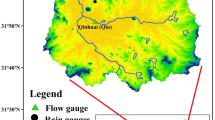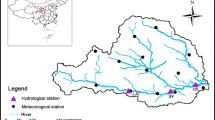Abstract
Climate change is likely to lead to an increased frequency and intensity of extreme weather events, including floods and droughts. Hydrological drought refers to deficiencies in surface and subsurface water supplies and is usually measured by streamflow, and lake, reservoir and ground water levels. Properly assessing hydrological drought is crucial to decision-making and management of regional water resources. In this study, changes in hydrological drought frequency over the Xijiang River Basin in South China are investigated through an analysis of daily streamflow data observed at major hydrological stations along the river during the period 1951–2013. The main results are as follows: (1) Standardized Runoff Drought Index is a suitable measure for regional hydrological drought research in the Xijiang Basin, as its correlation coefficient with actual disaster areas is above 0.6 for Wuzhou hydrological station; (2) the hydrological droughts in the Xijiang Basin typically have a short duration that are often less than 60 days; (3) there were three serious hydrological drought periods (the 1950s to mid-1960s, the late 1980s to mid-1990s and the mid-2000s to early 2010s) and two drought relief periods (the late 1960s to mid-1980s and the late 1990s to early 2000s) for the Xijiang Basin; (4) hydrological droughts in the Xijiang River occur frequently and are mainly concentrated in summer and spring, although serious hydrological droughts can easily arise in autumn. Droughts tend to be more frequent but less severe moving from upstream to downstream, and a long duration often accompanies high severity for a single drought event; and (5) severe hydrological droughts in upstream and midstream areas are characterized by long durations and high severities, respectively. Return periods based on copula could generally reflect actual drought situations, and severe and extreme hydrological droughts occur when return periods greater than 20 and 50 a, respectively.










Similar content being viewed by others
References
Bordi I, Fraedrich K, Jiang JM, Sutera A (2004) Spatio-temporal variability of dry and wet periods in eastern China. Theor Appl Climatol 79(1–2):81–91
Chebana F, Ouarada T (2011) Multivariate quantiles in hydrological frequency analysis. Environmetrics 22(1):63–78
Chen Z, Yang G (2013) Analysis of drought hazards in North China: distribution and interpretation. Nat Hazards 65(1):279–294
Dai A (2011) Drought under global warming: a review. Wiley Interdiscip Rev Clim Change 2(1):45–65
Engeland K, Hisdal H, Frigessi A (2004) Practical extreme value modeling of hydrological floods and droughts: a case study. Extremes 7(1):5–30
FEMA (1995) National mitigation strategy: partnerships for building safer communities. Federal Emergency Management Agency, Washington, p 26
Fischer T, Gemmer M, Su B, Scholten T (2013) Hydrological long-term dry and wet periods in the Xijiang River basin, South China. Hydrol Earth Syst Sci 17(1):135–148
Fleig AK, Tallaksen LM, Hisdal H, Demuth S (2006) A global evaluation of streamflow drought characteristics. Hydrol Earth Syst Sci 10(4):535–552
Gemmer M, Fischer T, Jiang T, Su B, Liu LL (2011) Trends in precipitation extremes in the Zhujiang River basin, South China. J Clim 24(3):750–761
General UNS (1994) United Nations convention to combat drought and desertification in countries experiencing serious droughts and/or desertification, particularly in Africa. Particularly in Africa
Genest C, Mackay J (1986) The joy of copulas: bivariate distributions with uniform marginals. Am Stat 40(4):280–283
Govindaraju RS (2013) Special issue on Data-driven approaches to droughts. J Hydrol Eng 18(7):735–736
Hao JJ, Lu GH, Yan GX, Wu ZY (2010) Analysis of drought trend in Huanghuaihai Plain based on climate change. Water Resour Power 28(11):12–14 (in Chinese)
Hisdal H, Tallaksen LM, Frigessi A (2002) Handling non-extreme events in extreme value modelling of streamflow droughts. In: FRIEND 2002—regional hydrology: bridging the gap between research and practice, IAHS Publ. no. 274, pp 281–288
Hu CH, Wang JX, Wang YX, Li Y (2013) Review on research of hydrological drought index. Yangtze River 44(7):11–15 (in Chinese)
Jakubowski W, Radczuk L (2004) Estimation of hydrological drought characteristics NIZOWKA2003—software manual, on accompanying CD to: hydrological drought—processes and estimation methods for streamflow and groundwater. In: Tallaksen LM, van Lanen HAJ (eds) Developments in water science, vol 48. Elsevier Science B.V., Amsterdam
Joe H (1997) Parametric families of copulas in multivariate models and dependence concepts. Springer, Berlin, pp 139–168
Kao SC, Govindaraju RS (2010) A copula-based joint deficit index for droughts. J Hydrol 380(1):121–134
Keyantash J, Dracup JA (2002) The quantification of drought: an evaluation of drought indices. Bull Am Meteorol Soc 83(8):1167–1180
Kwak JW, Kim YS, Lee JS, Kim HS (2012) Analysis of drought characteristics using copula theory. In: World Environmental and Water Resources Congress 2012, pp 1762–1771
Kwon H, Kim S (2010) Assessment of distributed hydrological drought based on hydrological unit map using SWSI drought index in South Korea. KSCE J Civ Eng 14(6):923–929
Li MJ (2008) Change scenario analysis of extreme climate events in the future in Shanxi province. Master thesis, Lanzhou University (in Chinese)
Lorenzo-Lacruz J, Vicente-Serrano SM, González-Hidalgo JC, López-Moreno JI, Cortesi N (2013) Hydrological drought response to meteorological drought in the Iberian Peninsula. Clim Res 58(2):117–131
Ma MW, Ren LL, Song SB, Song JL, Jiang SH (2013) Goodness-of-fit tests for multi-dimensional copulas: expanding application to historical drought data. Water Sci Eng 6(1):18–30
Madsen H, Rosbjerg D (1995) On the modeling of extreme droughts. In: Modelling and management of sustainable basin-scale water resources systems (Proceedings of Boulder symposium, July 1995), IAHS Publ. no 231,pp 377–385
McKee TB, Doesken NJ, Kleist J (1993) The relationship of drought frequency and duration to time scales. In: Proceedings of the 8th conference on applied climatology, vol 17, No. 22. American Meteorological Society, Boston, pp 179–183
Nelsen RB (1999) An introduction to copulas. Volume 139 of lecture notes in statistics, p 18
Palmer WC (1965) Meteorological drought. US Department of Commerce, Weather Bureau, Washington, p 58
Romm J (2011) The next dust bowl. Nature 478 (7370):450–451. doi:10.1038/478450a
Shiau JT (2006) Fitting drought duration and severity with two-dimensional copulas. Water Resour Manag 20(5):795–815
Shiau JT, Shen HW (2001) Recurrence analysis of hydrologic droughts of differing severity. J Water Resour Plan Manag 127(1):30–40
Sohrabi MM, Ryu JH, Abatzoglou J, Tracy J (2013) Climate extreme and its linkage to regional drought over Idaho, USA. Nat Hazards 65(1):653–681
Sui X, Wu SN, Liao WG, Jia L, Jin TT, Zhang X (2013) Optimized operation of cascade reservoirs on Wujiang River during 2009–2010 drought in southwest China. Water Sci Eng 6(3):308–316
Svoboda M, LeComte D, Hayes M, Heim R, Gleason K, Angel J, Rippey B, Tinker R, Palecki M, Stooksbury D, Miskus D, Stephens S (2002) The drought monitor. Bull Am Meteorol Soc 83(8):1181–1190
Tallaksen LM, Madsen H, Clausen B (1997) On the definition and modelling of streamflow drought duration and deficit volume. Hydrol Sci J 42(1):15–33
Wang XL, Gu Y, Zhu DL (2013) Future agricultural drought changing trend under climate change. Water Resour Hydropower Eng 2(44):17–19 (in Chinese)
Wong G (2013) A comparison between the Gumbel–Hougaard and distorted Frank copulas for drought frequency analysis. Int J Hydrol Sci Technol 3(1):77–91
Wong G, Lambert MF, Leonard M, Metcalfe AV (2009) Drought analysis using trivariate copulas conditional on climatic states. J Hydrol Eng 15(2):129–141
Xu KH, Milliman JD, Xu H (2010) Temporal trend of precipitation and runoff in major Chinese Rivers since 1951. Glob Planet Change 73:219–232
Yang ZY, Yuan Z, Fang HY, Yan DH (2013) Study on the characteristic of multiply events of drought and flood probability in Luanhe River Basin based on copula. J Hydraul Eng 44(5):556–569 (in Chinese)
Yu M, Li Q, Hayes MJ, Svoboda MD, Heim RR (2014) Are droughts becoming more frequent or severe in China based on the standardized precipitation evapotranspiration index: 1951–2010? Int J Climatol 34(3):545–558
Yusof F, Hui-Mean F, Suhaila J, Yusof Z (2013) Characterisation of drought properties with bivariate copula analysis. Water Resour Manag 27(12):4183–4207
Zaidman MD, Rees HG (2000) Spatial patterns of streamflow drought in Western Europe 1960–1995. Technical report to the ARIDE project
Zaidman MD, Rees HG, Young AR (2002) Spatio-temporal development of streamflow droughts in north-west Europe. Hydrol Earth Syst Sci Dis 6(4):733–751
Zelenhasić E, Salvai A (1987) A method of streamflow drought analysis. Water Resour Res 23(1):156–168
Zhang YL, He D, Gao QZ (2006) Climate characteristics of temperature variation in Xijiang River watershed. Resour Sci 28(3):30–36 (in Chinese)
Zhu YJ, Guo CQ, Huang XK (2012) Trend analysis of precipitation extreme values of Xijiang River Basin. J China Hydrol 32(2):72–77 (in Chinese)
Acknowledgments
This work is supported by the Special Public Sector Research Program of Ministry of Water Resources (Grant Nos. 201301040 and 201401008), the Foundation for the Author of National Excellent Doctoral Dissertation of PR China (Grant No. 201161), the Qing Lan Project and Program for New Century Excellent Talents in University (Grant number NCET-12-0842), the Natural Science Foundation of Jiangsu Province of China (Grant number BK20131368), and the Postgraduate Research Innovation Projects of Jiangsu Province of China (Grant number 2014B35014). The authors would like to thank Dr. Lei Wen, Dr. Raymond P. Mothathe and the reviewers for their advice and comments that help improve the manuscript.
Author information
Authors and Affiliations
Corresponding author
Rights and permissions
About this article
Cite this article
Wu, Z., Lin, Q., Lu, G. et al. Analysis of hydrological drought frequency for the Xijiang River Basin in South China using observed streamflow data. Nat Hazards 77, 1655–1677 (2015). https://doi.org/10.1007/s11069-015-1668-z
Received:
Accepted:
Published:
Issue Date:
DOI: https://doi.org/10.1007/s11069-015-1668-z




